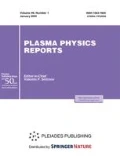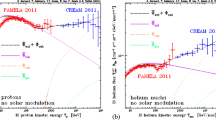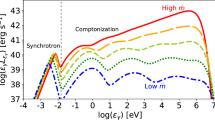Abstract
A three-component phenomenological model describing the specific features of the spectrum of cosmic-ray protons and helium nuclei in the rigidity range of 30–2×105 GV is proposed. The first component corresponds to the constant background; the second, to the variable “soft” (30–500 GV) heliospheric source; and the third, to the variable “hard” (0.5–200 TV) source located inside a local bubble. The existence and variability of both sources are provided by the corresponding “surfatron accelerators,” whose operation requires the presence of an extended region with an almost uniform (in both magnitude and direction) magnetic field, orthogonally (or obliquely) to which electromagnetic waves propagate. The maximum energy to which cosmic rays can be accelerated is determined by the source size. The soft source with a size of ∼100 AU is located at the periphery of the heliosphere, behind the front of the solar wind shock wave. The hard source with a size of >0.1 pc is located near the boundary of an interstellar cloud at a distance of ∼0.01 pc from the Sun. The presence of a kink in the rigidity spectra of p and He near 230 GV is related to the variability of the physical conditions in the acceleration region and depends on the relation between the amplitudes and power-law exponents in the dependences of the background, soft heliospheric source, and hard near galactic source. The ultrarelativistic acceleration of p and He by an electromagnetic wave propagating in space plasma across the external magnetic field is numerically analyzed. Conditions for particle trapping by the wave and the dynamics of the particle velocity and momentum components are considered. The calculations show that, in contrast to electrons and positrons (e +), the trapped protons relatively rapidly escape from the effective potential well and cease to accelerate. Due to this effect, the p and He spectra are softer than that of e +. The possibility that the spectra of accelerated protons deviate from standard power-law dependences due to the surfatron mechanism is discussed.
Similar content being viewed by others
References
O. Adriani, G. C. Barbarino, G. A. Bazilevskaya, R. Bellotti, M. Boezio, E. A. Bogomolov, L. Bonechi, M. Bongi, V. Bonvicini, S. Borisov, S. Bottai, A. Bruno, F. Cafagna, D. Campana, R. Carbone, et al., Science 332, 69 (2011).
A. D. Panov, J. H. Adams, H. S. Ahn, G. L. Bashinzhagyan, J. W. Watts, J. P. Wefel, J. Wu, O. Ganel, T.G. Guzik, V. I. Zatsepin, I. Isbert, K. C. Kim, M. Christl, E. N. Kouznetsov, M. I. Panasyuk, et al., Bull. Russian Acad. Sci., Physics 73, 564 (2009).
S. Haino, T. Sanuki, K. Abe, K. Anraku, Y. Asaoka, H. Fuke, M. Imori, A. Itasaki, T. Maeno, Y. Makida, S. Matsuda, N. Matsui, H. Matsumoto, J. W. Mitchell, A. A. Moiseev, et al., Phys. Lett. B 594, 35 (2004).
H. S. Ahn, P. Allison, M. G. Bagliesi, J. J. Beatty, G. Bigongiari, J. T. Childers, N. B. Conklin, S. Coutu, M. A. Du Vernois, O. Ganel, J. H. Han, J. A. Jeon, K. C. Kim, M. H. Lee, L. Lutz, et al., Astrophys. J. Lett. 714, 89 (2010).
Y. S. Yoon, H. S. Ahn, P. S. Allison, M. G. Bagliesi, J. J. Beatty, G. Bigongiari, P. J. Boyle, J. T. Childers, N. B. Conklin, S. Coutu, M. A. Du Vernois, O. Ganel, J. H. Han, J. A. Jeon, K. C. Kim, et al., Astrophys. J. 728, 122 (2011).
V. A. Derbina, V. I. Galkin, M. Hareyama, Y. Hirakawa, Y. Horiuchi, M. Ichimura, N. Inoue, E. Kamioka, T. Kobayashi, V. V. Kopenkin, S. Kuramata, A. K. Managadze, H. Matsutani, N. P. Misnikova, R. A. Mukhamedshin, et al., Astrophys. J. Lett. 628, 41 (2005).
P. L. Biermann, J. K. Becker, J. Dreyer, A. Meli, E.-S. Seo, and T. Stanev, Astrophys. J. 725, 184 (2010).
Y. Ohira and K. Ioka, Astrophys. J. Lett. 729, 13 (2011).
M. Kafatos, F. Bruhweiler, and S. Sofia, in Proceedings of the 17th International Cosmic Ray Conference, Paris, 1981, Vol. 2, p. 22.
M. A. Malkov, P. H. Diamond, and R. Z. Sagdeev, Phys. Rev. Lett. 108, 081104 (2012).
V. I. Zatsepin and N. V. Sokolskaya, Astron. Astrophys. 458, 1 (2006).
T. Katsouleas and J. M. Dawson, Phys. Rev. Lett. 51, 392 (1983).
N. S. Erokhin, S. S. Moiseev, and R. Z. Sagdeev, Sov. Astron. Lett. 15, 1 (1989).
G. N. Kichigin, JETP 92, 895 (2001).
V. M. Loznikov and N. S. Erokhin, Vopr. At. Nauki Tekh., Ser. Plazm. Elektron. Novye Metody Uskor., No. 4, 121 (2010).
V. M. Loznikov, N. S. Erokhin, and L. A. Mikhailovskaya, Kosm. Issl. 51 (3), 191 (2013).
V. M. Loznikov, N. S. Erokhin, and L. A. Mikhailovskaya, Plasma Phys. Rep. 39, 829 (2013).
G. N. Kichigin, JETP Lett. 87, 343 (2008).
K. V. Ptitsyna and S. V. Troitskii, Phys. Usp. 53, 691 (2010).
V. B. Baranov, M. G. Lebedev, and V. S. Ruderman, Astrophys. Space Sci. 66, 441 (1979).
S. Grzedzielski, M. Bzowski, A. Czechowski, H. O. Funsten, D. J. McComas, and N. A. Schwadron, Astrophys. J. 715, 84 (2010).
D. A. Gurnett and W. S. Kurth, Nature 454, 78 (2008).
D. A. Gurnett, W. S. Kurth, L. F. Burlaga, and N. F. Ness, Science 341, 1489 (2013).
S. A. Fuselier and I. H. Cairns, Astrophys. J. 771, 83 (2013).
I. H. Cairns, in The Sun, the Solar Wind, and the Heliosphere (IAGA Special Sopron Book Series, Vol. 4), Ed. by M. P. Miralles and J. Sánchez Almeida (Springer, Berlin, 2011), p. 267.
A. D. Erlykin and A. W. Wolfendale, Astroparticle Phys. 35, 449 (2012).
P. Mertsch and S. Sarkar, http://xxx.lanl.gov/pdf/1402.0855v2
Author information
Authors and Affiliations
Corresponding author
Additional information
Original Russian Text © V.M. Loznikov, N.S. Erokhin, N.N. Zol’nikova, L.A. Mikhailovskaya, 2016, published in Fizika Plazmy, 2016, Vol. 42, No. 7, pp. 649–657.
Rights and permissions
About this article
Cite this article
Loznikov, V.M., Erokhin, N.S., Zol’nikova, N.N. et al. On the reason for the kink in the rigidity spectra of cosmic-ray protons and helium nuclei near 230 GV. Plasma Phys. Rep. 42, 658–665 (2016). https://doi.org/10.1134/S1063780X16070072
Received:
Published:
Issue Date:
DOI: https://doi.org/10.1134/S1063780X16070072




